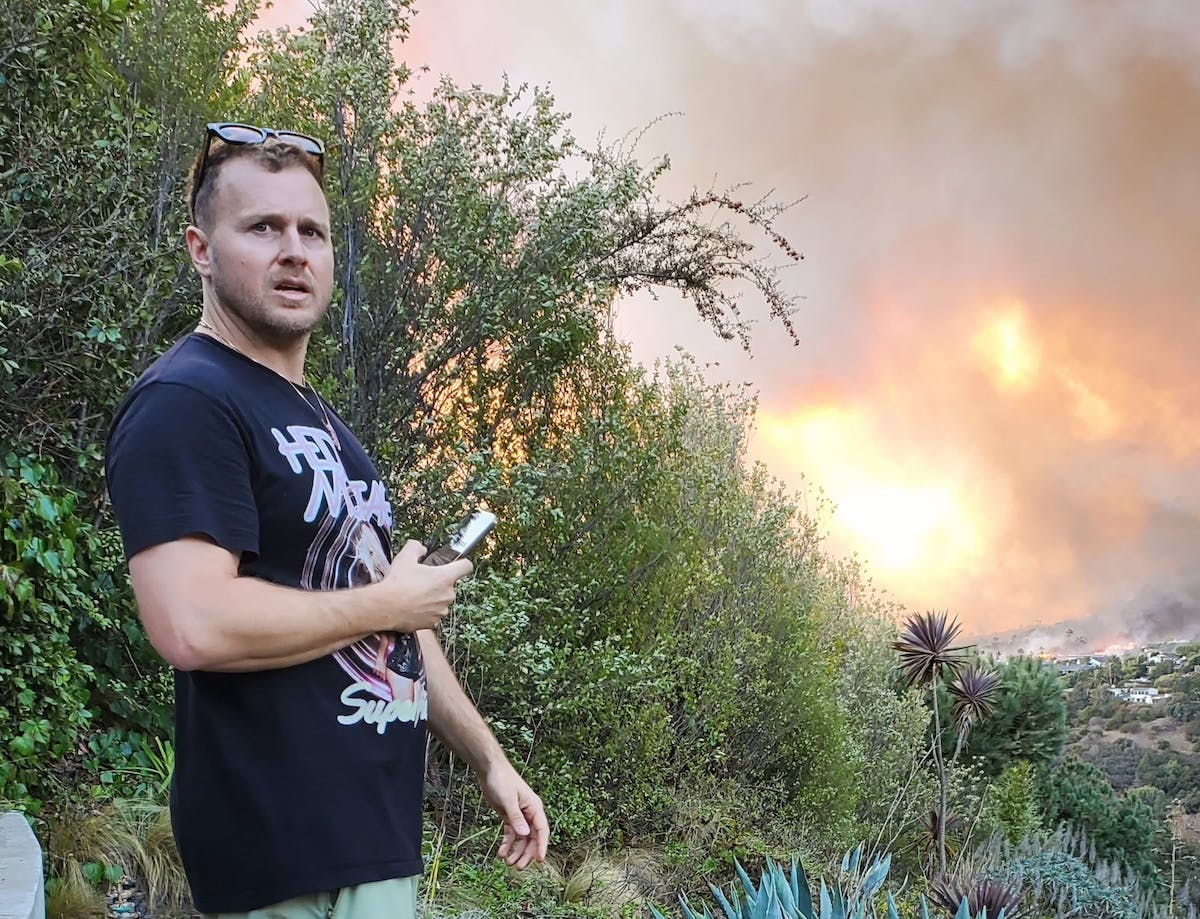Meet the man who fought off the Los Angeles wildfires with a garden hose


John Carr faced the hellish wildfire with nothing but a garden hose.
Fallen power lines and abandoned cars littered the roads as flames swept through Los Angeles, scorching over 40,000 acres, destroying 12,000 buildings, and leaving at least 24 people dead.
Despite his wife's pleas for him to leave, Carr texted her at 12:48 p.m., confirming that he intended to stay and fight.
Pacific Palisades, where Carr lives, became a scene of chaos as evacuation orders sent 150,000 residents scrambling to escape. The neighborhood suffered the brunt of the devastation.
His parents had built the house in 1960, and the thought of losing it was unbearable. As the inferno ripped through the hills and surged toward his house, he thought about all the memories of his parents, all the positive times that they shared. He and his wife have lived in the house for decades.
“A lot of what pushed me to save the house was saving it for her,” he told me over the phone. He wanted her to come home to the place she loves.
He wasn’t about to abandon it without a fight. “That's the thing that stuck in my head the most.”
Decisive action
Other articles about Carr’s unbelievable experience have stopped there — which is understandable, given the Hollywood-esque imagery of a lone man fighting off the cruelties of nature with equipment better suited for watering flower beds.
But they have overlooked the fact that Carr knew exactly what he was doing, taking decisive action with the kind of calm mindfulness found in Navy SEALs. He wasn’t some bravado-fueled daredevil; his plan was highly strategic. This makes his courage all the more impressive.
Carr had spent years troubleshooting various scenarios, asking himself, “If a fire came from this direction, what would we do? If the fire came from that direction, what would we do?”
His planning was grounded in the geography of the area and the behavior of the Santa Ana winds.
“So I was analyzing all those factors,” he told me, “and thought about it and figured it was — defending the house was something that I could do.”
An ominous view
When the Palisades fire broke out, Carr’s wife, Chiaki, a flight attendant, was en route to Japan's Haneda Airport. She had left their Palisades home early that morning. Just before boarding her flight, she received a text from Carr: He’d heard about a brushfire nearby and was going to check it out.
Minutes later, a mandatory evacuation order was issued for their neighborhood. As her plane took off, she looked out the window and saw smoke rising near their home. “It was so windy,” she later recounted, “and the turbulence was terrible.”
All she could think about was John and the house.
Despite her pleas for him to leave, Carr texted her at 12:48 p.m., confirming that he intended to stay and fight.
A wife’s journey home
As the hours passed, communication between Carr and his wife became sporadic. By 3:00 p.m., she had received an update from a neighbor: The fire was spreading across Marquez and Bollinger Circle, but their house was still standing. She was desperate for news. The uncertainty was excruciating.
Chiaki began coordinating with Delta Airlines to expedite her return to Los Angeles. By evening, friends had managed to reach John on a landline. They told her he was safe, but she was still terrified. And she still had to serve passengers coffee and drinks.
At Haneda Airport, she boarded a return flight, but when she landed at LAX on January 8, she couldn’t reach John.
“I started to imagine [the worst] about what happened to him fighting fire all night,” she said. “I thought the whole town had burned, including our house.”
She tried to reach him again and again. A friend reported John as a lost person.
Driving back to Pacific Palisades, she found all roads blocked by police barricades. Finally, at 2:29 p.m., a police officer called with news: John was alive and still at their home.
27 hours
Carr had fought the fire, alone, for 27 hours. Sleep-deprived, he put out spot fires, leaped fences, and even injured a rib in the process.
The fire devastated John Carr’s neighborhood. To the south, an entire row of houses was reduced to ash. Across Sunset Boulevard to the north, nearly 80% of the homes were destroyed. But Carr wasn’t just fighting to save his own house — he was determined to protect whatever he could.
When flames ignited a neighbor’s palm tree to the east, Carr climbed the wall and doused it with hose water, putting out multiple spot fires before they could spread. “There was a huge bonfire of acrylic tiles around the pool.”
The house’s hose didn’t work, so Carr kicked through a fence, dragged over his own hose, and put out the flames. “Fires like this can smolder underground through roots and soil,” he explained. “You have to soak them again and again to make sure they’re out.”
Not every attempt succeeded. To the southwest, Carr broke into another property to extinguish a growing fire, but the hose on the site was useless and his own hose couldn’t reach. “There was just a silly little hose,” he told me. “I could’ve saved it if I’d had the right hose.”
Still, Carr’s strategy was clear: stop small fires before they become house fires. “If you nip these things in the bud, you can save the houses,” he said. His quick actions saved multiple homes. “It’s straightforward, but it’s critical. You just do what you can.”
The guy upstairs
While Carr’s actions were heroic, he’s quick to emphasize that they weren’t impulsive.
He believes preparation is key, not just for wildfires but for any emergency. “You don’t have to be a prepper,” he said. “Just think about if you were in a situation where you could not go to the market for two weeks or so. What could you eat? What could you eat? What could you drink?”
But these vital questions get lost in the whir of our lives.
“People are just so busy trying to make a living; they don't always have time to think about preparations.”
While his planning gave him the tools to act, his faith and determination carried him through. Reflecting on the ordeal, he summed it up matter-of-factly: “The guy upstairs was helping out. I couldn’t have done it alone.”
The value of preparation
John’s story is a testament to self-reliance and courage. But the biggest takeaway isn’t his bravery — it’s the value of preparation. Wildfires are vicious, unpredictable, and fast, and defending your home starts long before the flames arrive. Here are some practical self-defense strategies you can use to protect your home — not from crime, but from any disaster that comes your way.
Sources include a FEMA booklet titled "Protect Your Property from Wildfires" and the National Fire Protection Association's “Home Ignition Zone Checklist.” There’s a wealth of information online with more detailed guidelines.
Start with the basics
Preparation starts with the basics. Review your homeowner's insurance policy regularly to ensure that it includes coverage for wildfire damage. It’s a simple step that can save you enormous trouble later. As part of your planning, take photos or videos of your home’s interior, focusing on high-value items. Having a detailed record can make the insurance claims process faster and easier if disaster strikes.
Every home should also have an emergency “go bag.” This bag should include essentials like a first aid kit, a flashlight with extra batteries, cash or cards, spare car keys, copies of important documents, and charger cords. Don’t forget to pack medications, as well as enough food and water to last three days for every person in your household. These small steps can make a big difference when time is of the essence.
Fortify your home
The National Fire Protection Association emphasizes that most homes ignite during wildfires because of their surroundings and structural vulnerabilities. Addressing these weak spots can significantly reduce your risk. Start at the top: If you haven’t already, replace your roof with Class A-rated, noncombustible materials like metal, asphalt shingles, or clay tiles. The roof is one of the most vulnerable parts of a house during a wildfire, and upgrading it is one of the best investments you can make.
Pay attention to your eaves and vents as well. Short eaves prevent embers from lodging, while vents covered with 1/8-inch wire mesh can block firebrands from entering your attic. Beyond that, creating defensible space around your home is crucial. The area within 30 feet of your house, known as Zone 1, should be kept free of flammable materials.
Prune trees, clear dead vegetation, and use noncombustible landscaping materials like gravel or concrete. Zone 2, which extends from 30 to 100 feet, requires thinning vegetation and removing “ladder fuels” that allow fire to climb into tree canopies.
Simple maintenance tasks, like cleaning your gutters and enclosing your foundation, can also go a long way. Gutters often collect dry leaves and debris, which can ignite easily during a wildfire. Sealing openings around utility connections with fire-resistant caulk or mortar can stop embers from sneaking inside.
Windows and walls need attention too. Install multipaned, tempered glass windows to shield against radiant heat, and use fire-resistant siding materials like stucco or fiber cement. Adding external sprinklers or water tanks to your property is another proactive step. And don’t forget: Every inch of your property matters. Make sure hoses can reach all areas, and consider installing rain barrels or even a pool to ensure a ready water supply.
Even your landscaping choices can make a difference. Fire-resistant plants, if watered regularly, can act as a barrier to slow flames. But neglected plants can dry out and become fuel for the fire. Choosing the right plants — and keeping them hydrated — can protect your home in surprising ways.
Be ready to evacuate
When wildfires strike, the best defense is often a quick and orderly evacuation. Experts recommend leaving early, even before evacuation orders are issued. Fires are unpredictable, and waiting too long can trap you in heavy traffic — or worse, in the path of the fire itself.
To stay ahead of disaster, use tools like FEMA’s mobile app, which provides real-time alerts. NOAA Weather Radio is another valuable resource, offering continuous updates on fire conditions and evacuation notices. Identify multiple evacuation routes from your home and set a designated meeting point where family members can regroup if separated.
If time allows, soak your property to create a buffer. Hook up hoses, fill tubs and trash cans, and douse your surroundings with water. The USDA also recommends shutting off gas and power if it can be done safely. Closing all doors, windows, and vents can help keep embers out, protecting your home’s interior.
Originally Published at Daily Wire, Daily Signal, or The Blaze
What's Your Reaction?
 Like
0
Like
0
 Dislike
0
Dislike
0
 Love
0
Love
0
 Funny
0
Funny
0
 Angry
0
Angry
0
 Sad
0
Sad
0
 Wow
0
Wow
0










































































